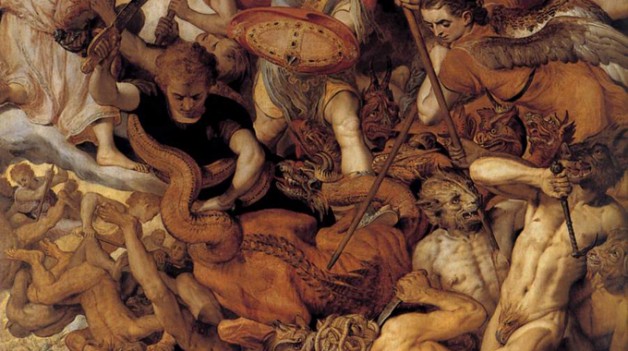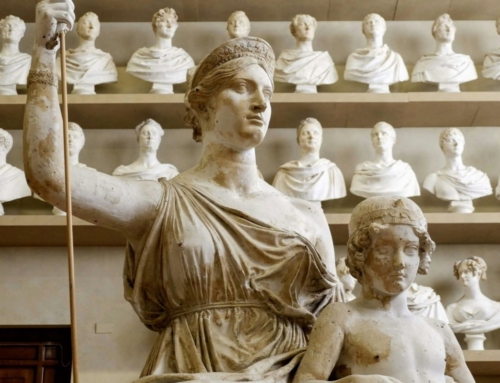Then God’s temple in heaven was opened, and the ark of his covenant could be seen in the temple. There were flashes of lightning, rumblings, and peals of thunder, an earthquake, and a violent hailstorm. A great sign appeared in the sky, a woman clothed with the sun, with the moon under her feet, and on her head a crown of twelve stars.
—Revelation 11:19-12:1
In Chapter 12 appears the vision of the woman and the dragon. It is probably best to see this as the start of another vision within the book, wherein salvation history is presented over again in a different way. This vision contains the rebellion of the devil and his angels, and it wouldn’t do to say that happened chronologically after all the things seen up to this point in the Book of Revelation.
The woman symbolically represents the People of God, namely Israel or the Church. Note that this is one continuous people, as the righteous of the Old Covenant were part of the Church, and the Church is what Israel has become.
Though of course we recognize the strong likeness to Our Lady because she stands alone as the most excellent exemplar of the Church, the primary referent of the symbol of the woman is the Church. St. Bede actually makes no mention of Mary in commenting on this passage; he says simply that the woman symbolizes the Church. Nevertheless, it is certainly fitting that popular piety sees this image as applicable to Our Lady, symbolically taking the “labor pains” to mean the suffering she experienced spiritually on Jesus’ behalf. Outside St. John’s vision, we see that when the Blessed Mother appears to saints such as Juan Diego it pleases God that she apply this imagery to herself.
The dragon that attacks the woman is explained in the text as “the ancient serpent, who is called the Devil and Satan.” This is as explicit an identification as we could want, and it also identifies the serpent of Genesis 3 as the Devil. St. Bede notes a similarity between the dragon and the scorpion-locust monsters in chapter 9—they both attack using their tails. He thinks this unseemly mode of attack is fitting for monsters that symbolize wicked persons who achieve their goals by means of fraud and falsehood.
We can note in passing that even though the dragon “swept away a third of the stars in the sky” in this vision, St. Thomas Aquinas does not want to commit to saying 33 1/3% of the angels followed Satan in his rebellion. Without speculating on proportions, he restricts himself to saying that it is fitting to suppose that “more angels stayed firm than sinned.”
Chapter 13 – The Beasts
Here the famous Beasts make their appearance. Remember that the beasts in Daniel are wicked kings who persecute God’s people and cause them to sin. The first beast in Revelation, then, is a wicked ruler who serves the devil and does his will. We can see from its position as the lieutenant of the dragon and from the supreme religious deception it practices that this beast must signify the one who is called the Antichrist.
One important thing to notice about the deception of the Beast in the vision is how it constantly mocks God, imitating him in a perverse parody. It fulfills both senses of what the prefix “anti-” means in Greek. The first meaning, of course, is that it opposes Christ. The second is that it is a sort of ersatz Christ. Think of the word “antipope,” which is used of someone who pretends to be the pope, but isn’t. The Beast mocks the praise given to God in the name of his nemesis, Michael. “Michael” in Hebrew means “Who is like God”; the Beast says “Who is like the Beast,” putting himself in God’s place. The beast wears many crowns (diadems), which belong in truth to Christ, and rules over “every tribe, people, tongue, and nation.” Imitating God, it also commands a second beast (Rev 13:11-18) who acts as the false prophet of the false messiah. This second beast partly resembles a lamb, in its horns, but it “speaks like a dragon.” It stamps people with the infamous “mark of the beast,” a demonic mockery of the seal of God we saw instituted in Chapter 7.
This ersatz Christ deceives multitudes into worshipping him, but those who are among the elect are not deceived. Think about what we have learned about how the Book of Revelation works. The ones who are able to enter into its mysteries are not those who can solve complicated mathematical puzzles or are learned in worldly wisdom. Although learning and the study of history can serve us well if they are at the service of our faith, it is faith and knowledge of God that grant us access.
In the vision the multitudes are deceived by a beast that does not look very much at all like the Lamb! It only has horns like a lamb, though it speaks like a dragon. If they knew the Lamb well at all, they wouldn’t be fooled for one minute. Compare it to fake versions of things you know. Suppose you loved coffee and drank it every day. No one could pass off ersatz coffee on you. You’d notice it instantly. But suppose you never drank coffee but had only seen it from a distance, or you had only tasted it once or twice (If you are a coffee fan, did you even like it the first time you tried it?). In that case, someone could put any warm brown bilgewater in front of you and tell you it’s coffee, and there’s a good chance you’d believe him. And if all the cool people were drinking it, and all the people you wanted to impress, you might well be moved to choke it down, even if it was disgusting.
It’s the same thing with Christ versus the fake Christ. If we know Christ and his Church well, and are intimate with them, then the difference between the genuine article and the diabolic fake will be apparent. The powerful signs and wonders that Jesus says the false messiahs and false prophets will work (Matthew 24:24, Mark 13:22) will not deceive us. But if we can’t be bothered with Christ and his Church, or only know fake and imitation versions to begin with, then we might just fall for the Antichrist and his assembly.
Image: Frans Floris, The Fall of the Rebellious Angels







